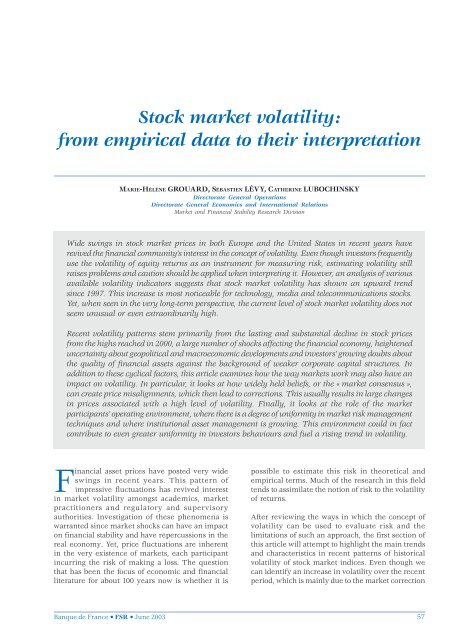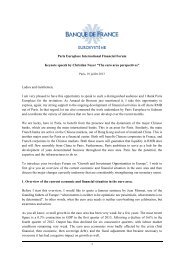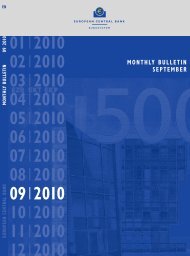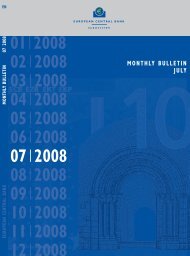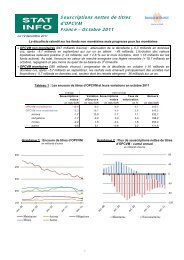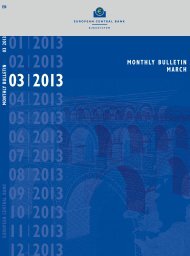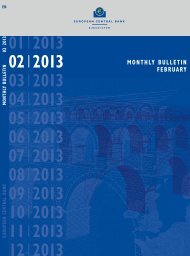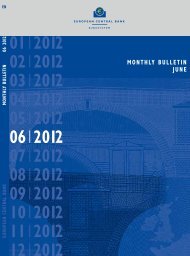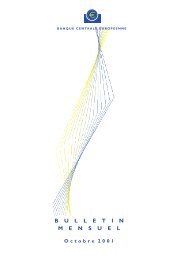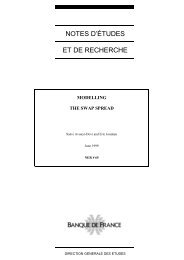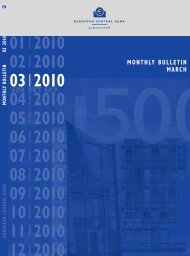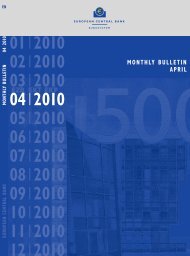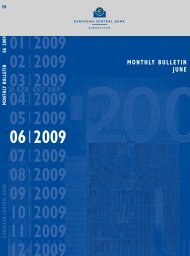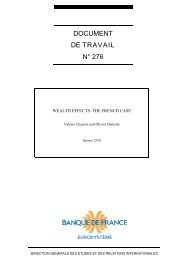Stock market volatility: from empirical data to their interpretation
Stock market volatility: from empirical data to their interpretation
Stock market volatility: from empirical data to their interpretation
You also want an ePaper? Increase the reach of your titles
YUMPU automatically turns print PDFs into web optimized ePapers that Google loves.
<strong>S<strong>to</strong>ck</strong> <strong>market</strong> <strong>volatility</strong>:<strong>from</strong> <strong>empirical</strong> <strong>data</strong> <strong>to</strong> <strong>their</strong> <strong>interpretation</strong>MARIE-HÉLÈNE GROUARD, SÉBASTIEN LÉVY, CATHERINE LUBOCHINSKYDirec<strong>to</strong>rate General OperationsDirec<strong>to</strong>rate General Economics and International RelationsMarket and Financial Stability Research DivisionWide swings in s<strong>to</strong>ck <strong>market</strong> prices in both Europe and the United States in recent years haverevived the financial community’s interest in the concept of <strong>volatility</strong>. Even though inves<strong>to</strong>rs frequentlyuse the <strong>volatility</strong> of equity returns as an instrument for measuring risk, estimating <strong>volatility</strong> stillraises problems and caution should be applied when interpreting it. However, an analysis of variousavailable <strong>volatility</strong> indica<strong>to</strong>rs suggests that s<strong>to</strong>ck <strong>market</strong> <strong>volatility</strong> has shown an upward trendsince 1997. This increase is most noticeable for technology, media and telecommunications s<strong>to</strong>cks.Yet, when seen in the very long-term perspective, the current level of s<strong>to</strong>ck <strong>market</strong> <strong>volatility</strong> does notseem unusual or even extraordinarily high.Recent <strong>volatility</strong> patterns stem primarily <strong>from</strong> the lasting and substantial decline in s<strong>to</strong>ck prices<strong>from</strong> the highs reached in 2000, a large number of shocks affecting the financial economy, heighteneduncertainty about geopolitical and macroeconomic developments and inves<strong>to</strong>rs’ growing doubts aboutthe quality of financial assets against the background of weaker corporate capital structures. Inaddition <strong>to</strong> these cyclical fac<strong>to</strong>rs, this article examines how the way <strong>market</strong>s work may also have animpact on <strong>volatility</strong>. In particular, it looks at how widely held beliefs, or the « <strong>market</strong> consensus »,can create price misalignments, which then lead <strong>to</strong> corrections. This usually results in large changesin prices associated with a high level of <strong>volatility</strong>. Finally, it looks at the role of the <strong>market</strong>participants’ operating environment, where there is a degree of uniformity in <strong>market</strong> risk managementtechniques and where institutional asset management is growing. This environment could in factcontribute <strong>to</strong> even greater uniformity in inves<strong>to</strong>rs behaviours and fuel a rising trend in <strong>volatility</strong>.Financial asset prices have posted very wideswings in recent years. This pattern ofimpressive fluctuations has revived interestin <strong>market</strong> <strong>volatility</strong> amongst academics, <strong>market</strong>practitioners and regula<strong>to</strong>ry and supervisoryauthorities. Investigation of these phenomena iswarranted since <strong>market</strong> shocks can have an impac<strong>to</strong>n financial stability and have repercussions in thereal economy. Yet, price fluctuations are inherentin the very existence of <strong>market</strong>s, each participantincurring the risk of making a loss. The questionthat has been the focus of economic and financialliterature for about 100 years now is whether it ispossible <strong>to</strong> estimate this risk in theoretical and<strong>empirical</strong> terms. Much of the research in this fieldtends <strong>to</strong> assimilate the notion of risk <strong>to</strong> the <strong>volatility</strong>of returns.After reviewing the ways in which the concept of<strong>volatility</strong> can be used <strong>to</strong> evaluate risk and thelimitations of such an approach, the first section ofthis article will attempt <strong>to</strong> highlight the main trendsand characteristics in recent patterns of his<strong>to</strong>rical<strong>volatility</strong> of s<strong>to</strong>ck <strong>market</strong> indices. Even though wecan identify an increase in <strong>volatility</strong> over the recentperiod, which is mainly due <strong>to</strong> the <strong>market</strong> correctionBanque de France • FSR • June 2003 57
<strong>S<strong>to</strong>ck</strong> <strong>market</strong> <strong>volatility</strong>: <strong>from</strong> <strong>empirical</strong> <strong>data</strong> <strong>to</strong> <strong>their</strong> <strong>interpretation</strong>under way since 2000, a longer-term view puts these<strong>volatility</strong> levels in<strong>to</strong> perspective and shows that awider-ranging investigation is necessary. The secondsection of the article analyses this increased<strong>volatility</strong>. It distinguishes between short-termexplana<strong>to</strong>ry fac<strong>to</strong>rs and structural fac<strong>to</strong>rs, such asthe impact of innovations in investment products andfund management techniques.1| Uncertainty, risk and <strong>volatility</strong>:<strong>from</strong> theory <strong>to</strong> <strong>empirical</strong> <strong>data</strong>Ever since F. Knight’s famous book was published in1921, distinction between risk, which can be measuredin terms of mathematical probabilities, anduncertainty, which cannot be measured, has beenapplied <strong>to</strong> many fields. In finance, for example,estimated asset price fluctuations are used <strong>to</strong> evaluate<strong>market</strong> risk and unforeseeable price swings areassumed <strong>to</strong> reflect uncertainty. Volatility of returnsis the most widely used concept for representing risk.His<strong>to</strong>rical <strong>volatility</strong> is used <strong>to</strong> analyse past or presentprices and expected <strong>volatility</strong> (or the implied <strong>volatility</strong>derived <strong>from</strong> option prices) is used <strong>to</strong> predict futureprice changes. Under this approach, the only realproblem for the various agents in the financialeconomy stems <strong>from</strong> unexpected <strong>volatility</strong>.After a review of the reasons for using <strong>volatility</strong> asan instrument for evaluating risk, with theunderstanding that it is merely an approximationand that the perception of risk varies for differenttypes of <strong>market</strong> participants, <strong>empirical</strong> observationsshow a recent increase in <strong>volatility</strong> on the main s<strong>to</strong>ck<strong>market</strong>s, albeit <strong>to</strong> different degrees in differentindustries. We also observe more frequent <strong>volatility</strong>peaks in the recent past. In a longer-termperspective, this paper highlights the persistence ofhigh <strong>volatility</strong> levels.1|1 A review of some conceptsVolatility as a proxy for riskUnder the assumption of a normal distribution ofreturns (i.e. s<strong>to</strong>ck prices follow a random walkprocess), which means that the distribution ofreturns is symmetrical, one can estimate theprobabilities of potential gains or losses associatedwith each amount. This means the standarddeviation of securities returns, which is calledhis<strong>to</strong>rical <strong>volatility</strong> and is usually calculated as amoving average, can be used as a risk indica<strong>to</strong>r. Theprices used for the calculations are usually theclosing prices, but Parkinson (1980) suggests thatthe day’s high and low prices would provide a betterestimate of real <strong>volatility</strong>. One can also refine theanalysis with high frequency <strong>data</strong>. Such <strong>data</strong> enable<strong>to</strong> avoid the bias stemming <strong>from</strong> the use of closing(or opening) prices, but they have only been availablefor a relatively short time. The length of theobservation period is another <strong>to</strong>pic that is still underdebate. There are no criteria that enable <strong>to</strong> concludethat <strong>volatility</strong> calculated in relation <strong>to</strong> mean returnsover 20 trading days (or one month) and thenannualised is any more or less representative than<strong>volatility</strong> calculated over 130 trading days (or sixmonths) and then annualised, or even than <strong>volatility</strong>measured directly over 260 trading days (one year).However, in reality, the distribution of returns isnot normal. This raises a first problem stemming<strong>from</strong> financial agents’ preferences. Theirpreferences are asymmetrical since they arenaturally much more concerned about the risk oflosses than by the risk of gains. Other riskmeasurements have therefore been developed. Mos<strong>to</strong>f them, including the ones recommended byprudential authorities, focus primarily on the notionof potential loss. More specifically, one can calculatethe semi-variance, which corresponds <strong>to</strong> a variancecalculated solely on the basis of negative deviations<strong>from</strong> the mean, the Value at Risk (VaR) or the extremepotential loss for a portfolio at a given time horizonand confidence interval. For example, betweenJanuary 2000 and March 2003, the his<strong>to</strong>rical <strong>volatility</strong>calculated for the CAC index, based on the annualisedstandard deviation of daily returns is 20%, whereasthe <strong>volatility</strong> calculated on the basis of the“semi-standard deviation” is 29.2%.Furthermore, it is restrictive <strong>to</strong> estimate only thefirst two moments of the distribution of returns(mean and variance), since the distributions can alsobe characterised by <strong>their</strong> third and fourth moments(skewness and kur<strong>to</strong>sis). This is a problem as theassumption of a normal distribution is rejected andit is admitted that the distribution of returns isskewed and lep<strong>to</strong>kurtic (see box 1). For example,58 Banque de France • FSR • June 2003
<strong>S<strong>to</strong>ck</strong> <strong>market</strong> <strong>volatility</strong>: <strong>from</strong> <strong>empirical</strong> <strong>data</strong> <strong>to</strong> <strong>their</strong> <strong>interpretation</strong>take two distributions: one that is normal (A) andone that is not (B). B may be a riskier distribution interms of Value at Risk, because it is more lep<strong>to</strong>kurtic.Yet, it may have a smaller standard deviation thanthat of distribution A, because the probabilities ofreturns in B are more centered around the mean.Yet, all of the risk models based on <strong>volatility</strong>measured by the standard deviation would show thatB is less risky than A.Box 1Formal presentation of the main conceptsContinuous return: t= LnMean return:SStr[ ]where S: security price or por<strong>to</strong>folio valuern∑rt = tt= 1nt –1Ln: napierian logarithmwhere n: number of observationsIf r tis normally distributed with a mean µ and a standard deviation σ, then the expected arithmetic return is:2+2µ σE(R t) =eStandard deviation:n∑tσ = t = 1 r( r r )n12Volatility is expressed as percent per year obtained by annualising the standard deviation.Semi-variance:sσrn2 =∑t = 1t( r r )n12for any r t≤ r if we are interested in returns below the mean.Value at Risk: VaR q(X) = the probability q that the loss will exceed an amount X over a given period(1-q that the loss does not exceed X over the given period). With a normal distribution,VaR q= E(r t) + Z q.σ rwhere Z qcorresponds <strong>to</strong> the quantile associated with probability q.Skewness of the distribution (third moment) s =( ) 3n∑ r t rn t = 13( n 1 )( n 2 ) σrIf the distribution is symmetrical (normal distribution), the skewness coefficient is equal <strong>to</strong> zero.Kur<strong>to</strong>sis (thickness of distribution tails, fourth moment) k =( )n 4r r( n∑n + 1)tt = 1( n 1)( n 2)( n 3)σ 4rA normal distribution has a kur<strong>to</strong>sis coefficient equal <strong>to</strong> 3. A coefficient greater than 3 indicates thick tails andthe distribution is qualified as lep<strong>to</strong>kurtic.Banque de France • FSR • June 2003 59
<strong>S<strong>to</strong>ck</strong> <strong>market</strong> <strong>volatility</strong>: <strong>from</strong> <strong>empirical</strong> <strong>data</strong> <strong>to</strong> <strong>their</strong> <strong>interpretation</strong>In illiquid <strong>market</strong>s, prices may not change over acertain period simply because no transactions takeplace. In this case, low <strong>volatility</strong> should not beinterpreted as indicating low <strong>market</strong> risk. It should beseen as a sign of high liquidity risk instead.Furthermore, wide price fluctuations may be necessaryin an illiquid <strong>market</strong> in order <strong>to</strong> match bid and offertransactions. In this case, the high price <strong>volatility</strong> isdue <strong>to</strong> illiquidity and not <strong>to</strong> changes in the fundamentalvalue of the assets. In other words, liquidity may be acritical fac<strong>to</strong>r for interpreting <strong>volatility</strong>.Clearly, <strong>volatility</strong> analysis alone does not providecomplete information about the <strong>market</strong> risk incurredby financial agents. Volatility is an approximate andbiased indica<strong>to</strong>r of risk, both in the case of <strong>empirical</strong><strong>volatility</strong> calculated <strong>from</strong> past prices (his<strong>to</strong>rical<strong>volatility</strong>) and in the case of implied <strong>volatility</strong> derived<strong>from</strong> option prices.In any case, <strong>volatility</strong> has <strong>to</strong> be estimated since itcannot be observed directly. Several models havebeen constructed <strong>to</strong> represent the dynamics of the<strong>volatility</strong> of returns and <strong>to</strong> attempt <strong>to</strong> forecast it. Thesemodels are very frequently au<strong>to</strong>regressive conditionalheteroskedasticity (ARCH) models, which wereintroduced by Engle in 1982 and then extended byBollersev in 1986 with the Generalised ARCH(GARCH) model. These models introduced explicitmodelling of the variance of returns. This variancefollows a specific temporal process. Thus, given thehis<strong>to</strong>rical information, the conditional distribution ofreturns is normal with a mean equal <strong>to</strong> zero andvariance of h t, which is a function of his<strong>to</strong>ricalvariance. This makes it possible <strong>to</strong> introduce acorrelation between returns and thereby formallyrepresent persistence phenomena (see Avouyi-Doviet al., 2002). These models, which have limitedpredictive powers, do not fall within the scope of thisarticle. The <strong>volatility</strong> measurement used here istherefore that of the his<strong>to</strong>rical standard deviation.But it is important <strong>to</strong> keep in mind the limits of this<strong>volatility</strong> indica<strong>to</strong>r as an instrument for measuringthe risk incurred by financial agents.Different perceptions of riskThe diversity of financial agents (ranging <strong>from</strong>theoreticians <strong>to</strong> practitioners) concerned with theconcept of <strong>volatility</strong> explains the diversity of theapproaches used <strong>to</strong> deal with this concept and thedebates surrounding it. All <strong>market</strong> participants have<strong>their</strong> own perception of risk (risk aversion function).The problem is <strong>to</strong> reconcile the theoretical conceptsof risk with risk estimates made by the inves<strong>to</strong>rs whohave adopted the notion of <strong>volatility</strong>.Following Granger (2002), a typology of agents wouldmake a distinction between:– mathematicians, who are interested in optionpricing theory, using a continuous-time approach.The need <strong>to</strong> integrate price <strong>volatility</strong> forecastin<strong>to</strong> option pricing led <strong>to</strong> thorough modellingof this forecasting and highlighted severalcharacteristics, such as the decreasing termstructure of <strong>volatility</strong>. Since <strong>volatility</strong> is the onlynon-observable component in an option price,reasoning directly in terms of <strong>volatility</strong> is the sameas reasoning in terms of prices. Thus, “implied”<strong>volatility</strong> derived <strong>from</strong> traded option pricescorresponds <strong>to</strong> the mean <strong>volatility</strong> expected by<strong>market</strong> participants;– econometricians and <strong>empirical</strong> statisticians. ARCH,GARCH and other models have revealed thephenomena of heteroskedasticity and <strong>volatility</strong>persistence (see 2|2 below). These approacheshave also highlighted the limitations of thenormally distributed returns assumption and thusthe limitations of his<strong>to</strong>rical <strong>volatility</strong> for assessing<strong>market</strong> risk, as well as the mean reversioncharacteristic of <strong>volatility</strong>;– economists using uncertainty theory. They workon portfolio theory, on the benefits ofdiversification, through the distinction madebetween specific risk and systematic risk, and onthe Capital Asset Pricing Model (CAPM), in which<strong>volatility</strong> plays a critical role in determiningreturns;– fund managers and traders (“<strong>market</strong>professionals”), whose objective is basically <strong>to</strong>maximise returns on <strong>their</strong> transactions (albeit witha different time horizon). For them, pricepredictability depends on <strong>volatility</strong>, or even the<strong>volatility</strong> of <strong>volatility</strong>. Their behaviour issometimes cited as an explana<strong>to</strong>ry fac<strong>to</strong>r of<strong>volatility</strong> (see 2|2 below). As for hedge funds, thediversity of <strong>their</strong> strategies makes it impossible<strong>to</strong> reach any conclusions about the impact of <strong>their</strong>behaviour on <strong>volatility</strong>. Nevertheless, it is widelyagreed that <strong>their</strong> arbitrage strategies improves<strong>market</strong> efficiency and that <strong>their</strong> transactionsimprove <strong>market</strong> liquidity;60 Banque de France • FSR • June 2003
<strong>S<strong>to</strong>ck</strong> <strong>market</strong> <strong>volatility</strong>: <strong>from</strong> <strong>empirical</strong> <strong>data</strong> <strong>to</strong> <strong>their</strong> <strong>interpretation</strong>– individual inves<strong>to</strong>rs are typically concerned aboutfalling prices, especially when <strong>their</strong> retirementpension depends on s<strong>to</strong>ck <strong>market</strong> investments.Individual inves<strong>to</strong>rs are also more concernedabout the <strong>volatility</strong> of specific securities than the<strong>volatility</strong> of s<strong>to</strong>ck <strong>market</strong> indices. These indicesshow less <strong>volatility</strong> when there is less correlationbetween securities.This classification should be expanded <strong>to</strong> includeprudential authorities and central banks, which areconcerned about the potential impact of increased<strong>volatility</strong> on systemic risk and financial stability.1|2 Empirical observations:<strong>volatility</strong> has showna rising trend since 1997A global phenomenonA widespread increase in <strong>volatility</strong>There has been a sharp increase in s<strong>to</strong>ck <strong>market</strong><strong>volatility</strong> in all western countries in the recent past.This followed a period in the first half of thenineteen-nineties, when <strong>volatility</strong> levels were verylow. The movement began in the second half of thenineteen-nineties, as shown in the chart 1, whichplots the annual his<strong>to</strong>rical <strong>volatility</strong> of some majors<strong>to</strong>ck <strong>market</strong> indices. After large increases between1997 and 1999, <strong>volatility</strong> stabilised at a high levelbefore resuming its upward trend in 2001. Annualhis<strong>to</strong>rical <strong>volatility</strong> reached levels in excess of 15 <strong>to</strong>20 percentage points above the mean estimated over15 years. In 2002 and 2003, the annual his<strong>to</strong>rical<strong>volatility</strong> of the CAC index was greater than 38%,whereas monthly <strong>volatility</strong> occasionally hit 60%(see charts 1 and 2).Comparing <strong>volatility</strong> patterns in variousindustrialised countries reveals <strong>their</strong> similarity. Allof the main s<strong>to</strong>ck <strong>market</strong> indices, whose correlationhas increased over the last ten years, have shownfairly similar <strong>volatility</strong> patterns. Japan is the onlycountry in this group where the <strong>volatility</strong> pattern isdifferent <strong>from</strong> that in the industrialised countries.Equity returns in Japan are less correlated with thosein US and European <strong>market</strong>s, primarily becauseJapan’s business cycle is not correlated with thoseof the United States or Europe.Chart 1Annual his<strong>to</strong>rical <strong>volatility</strong> of the SP 500,CAC 40 and FTSE 100 s<strong>to</strong>ck <strong>market</strong> indices(in %)4035302520151051988 1990 1992 1994 1996 1998 2000 2002CAC 40FTSE 100SP 500Sources: Banque de France, BloombergImplied <strong>volatility</strong> analysis confirms the rising trendin s<strong>to</strong>ck <strong>market</strong> <strong>volatility</strong>. In the French <strong>market</strong>,implied <strong>volatility</strong> derived <strong>from</strong> CAC 40 option pricesreached 60% on occasion in 2002 and 2003. Ananalysis of the differential between implied <strong>volatility</strong>and his<strong>to</strong>rical <strong>volatility</strong> seems <strong>to</strong> confirm an increasein inves<strong>to</strong>rs’ uncertainty over the last six years.Implied <strong>volatility</strong> was several percentage pointshigher than his<strong>to</strong>rical <strong>volatility</strong> (an average of2.5 percentage points between 1997 and 2003 in thecase of the CAC 40). This widening of the differentialindicates that inves<strong>to</strong>rs expect <strong>volatility</strong> <strong>to</strong> increasein the future. On the other hand, when his<strong>to</strong>rical<strong>volatility</strong> increases sharply, the differential betweenimplied and his<strong>to</strong>rical <strong>volatility</strong> usually turnsnegative, thus signalling that <strong>volatility</strong> is expected<strong>to</strong> return <strong>to</strong> more moderate levels. It is noteworthythat the decline in monthly his<strong>to</strong>rical <strong>volatility</strong>between September 2002 and March 2003 was notaccompanied by a fall in implied <strong>volatility</strong>, whichremained high, testifying <strong>to</strong> inves<strong>to</strong>rs’ persistentuncertainties.Banque de France • FSR • June 2003 61
<strong>S<strong>to</strong>ck</strong> <strong>market</strong> <strong>volatility</strong>: <strong>from</strong> <strong>empirical</strong> <strong>data</strong> <strong>to</strong> <strong>their</strong> <strong>interpretation</strong>Chart 2Monthly implied and his<strong>to</strong>rical <strong>volatility</strong>of the CAC 40 index(in %)655545352515211470- 7- 14Differences between industries can explain someof the differences in the <strong>volatility</strong> levels betweenthe indices, as can be seen in charts 3 and 4. Inthe recent past, the proportion of technology,telecommunications and media s<strong>to</strong>cks in each indexseems <strong>to</strong> largely account for the mean <strong>volatility</strong>differences between indices.Chart 3Index average monthly his<strong>to</strong>rical <strong>volatility</strong> (1987-2002)(in %)Nikkei5- 21S1 S2 S1 S2 S1 S2 S12000 2001 2002 2003Monthly realised <strong>volatility</strong>Implied <strong>volatility</strong>Differential (implied – realised) (right-hand scale)NasdaqCAC 40EuroS<strong>to</strong>xx 50Sources: Banque de France, BloombergDifferences in <strong>volatility</strong> levelsbetween indices and industriesEven though <strong>volatility</strong> patterns look similar for allindices, substantial differences between the <strong>volatility</strong>levels of indices can be seen. The monthly his<strong>to</strong>rical<strong>volatility</strong> of the CAC 40 index stands at 20%, whereasthat of the EuroS<strong>to</strong>xx and SP 500 indices stands atjust under 16%. Such differences arise <strong>from</strong> combinedfac<strong>to</strong>rs linked <strong>to</strong> the indices composition. The mains<strong>to</strong>ck <strong>market</strong> indices usually include the largest <strong>market</strong>capitalisations on the national s<strong>to</strong>ck exchange, but<strong>their</strong> composition varies greatly. The number ofcompanies included, the <strong>volatility</strong> of the individuals<strong>to</strong>cks tracked and the degree of diversification, asshown by the covariances between the s<strong>to</strong>cks tracked,can differ significantly.Similarly, the <strong>volatility</strong> of s<strong>to</strong>ck prices in differentindustries can also vary substantially. The <strong>data</strong> <strong>from</strong>a broad European index (EuroS<strong>to</strong>xx) show that someindustries like construction, food processing andutility, have registered very little <strong>volatility</strong> compared<strong>to</strong> other industries. Their s<strong>to</strong>ck prices have been lessvolatile than the index itself. On the other hand,technology s<strong>to</strong>cks, telecommunications s<strong>to</strong>cks and,<strong>to</strong> a lesser extent, media s<strong>to</strong>cks posted his<strong>to</strong>rical<strong>volatility</strong> over the same period that was more than10 percentage points greater than the <strong>volatility</strong> ofthe index (see chart 4).EuroS<strong>to</strong>xxDow JonesSP 500FTSE 100Sources: Banque de France, Bloomberg12 14 16 18 20 22Chart 4Monthly his<strong>to</strong>rical <strong>volatility</strong> for each industryin the EuroS<strong>to</strong>xx index since 1990(in %)TechnologyTelecomMediaAu<strong>to</strong>mobileCyclical goodsInsuranceHealthEnergy (oil)ChemicalsNon cyclical goodsRetailBasic resourcesBankingFinanceIndustryOverall indexUtilityAgri-foodConstruction14 16 18Sources: Banque de France, Bloomberg20 22 24 26 283062 Banque de France • FSR • June 2003
<strong>S<strong>to</strong>ck</strong> <strong>market</strong> <strong>volatility</strong>: <strong>from</strong> <strong>empirical</strong> <strong>data</strong> <strong>to</strong> <strong>their</strong> <strong>interpretation</strong>Chart 5Annualised 6-month his<strong>to</strong>rical <strong>volatility</strong>of the SP 500 and Nasdaq indices(in %)60504030201001973 1978 1983 1988 1993 1998 2003SP 500NasdaqSources: Banque de France, BloombergChart 6Monthly his<strong>to</strong>rical <strong>volatility</strong> and proportionof TMT s<strong>to</strong>cks in broad indices(Proportion of TMT s<strong>to</strong>cks / Monthly realised <strong>volatility</strong>)5550Nasdaq4540353025EuroS<strong>to</strong>xx20FTSE15 All-ShareBE 500Topix10 FTSE350SPSBF 250SP 50051 50016 18 20 22 24 26 28 30 32Sources: Banque de France, BloombergVolatility peaks have been more frequentand lasted longer since 1997Estimating <strong>volatility</strong> peaksIn addition <strong>to</strong> an increase in average <strong>volatility</strong>, therecent past has also seen an increase in the frequencyof <strong>volatility</strong> peaks, as illustrated by short-term <strong>volatility</strong>patterns in the charts 1, 2 and 5. A <strong>volatility</strong> peak is aphase during which <strong>volatility</strong> reaches a much higherlevel than its long-term mean. It can be determined<strong>empirical</strong>ly by analysing the distribution of <strong>volatility</strong>.Thus, after estimating <strong>volatility</strong> thresholds on thebasis of the distribution of the monthly his<strong>to</strong>rical<strong>volatility</strong> of the SP 500 index over the last 50 years, alook at the recent period allows two comments:– a sharp increase in the number of <strong>volatility</strong> peaksregardless of the thresholds chosen over 95% 1 . Thus,between 1997 and 2003, 6 out of the 7 yearsshowed <strong>volatility</strong> peaks at high distributionthresholds (up <strong>to</strong> 98%). This is the first time thatsuch a configuration has appeared in 50 years.Before that, <strong>volatility</strong> peaks were short-lived andspaced out;– an increase in the duration of <strong>volatility</strong> peaks, so muchso that some peaks could be called “<strong>volatility</strong>plateaus”. His<strong>to</strong>rical <strong>volatility</strong> reached the 97%threshold in 2002 and stayed there for 73 days.The only time it was greater was in 1950.Chart 7Number of days on which the monthly <strong>volatility</strong>of the SP 500 index s<strong>to</strong>od at an exceptional level2002200120001998199719891988198719821974197319701962195519500 20 40 60 80 100 12098% threshold (<strong>volatility</strong> level of 31.0%)97% threshold (<strong>volatility</strong> level of 27.7%)Sources: Banque de France, BloombergIntraday <strong>volatility</strong>Observation of intraday <strong>volatility</strong>, measured by thepercent change between the highest and lowest pricesreached during a trading day, confirms the precedingremarks. The intraday <strong>volatility</strong> pattern of theFTSE index shows an increase in the number andduration of <strong>volatility</strong> peaks very clearly (see chart 8). Italso highlights another distinctive feature of <strong>volatility</strong>1A “95% threshold” means that 95% of the observations in the sample are lower than the level selected. In the case of the SP 500, the 95%,97%, 98% and 99% thresholds correspond <strong>to</strong> <strong>volatility</strong> levels over 20 days of 24.3%, 27.7%, 31.0% and 34.7% respectively.Banque de France • FSR • June 2003 63
<strong>S<strong>to</strong>ck</strong> <strong>market</strong> <strong>volatility</strong>: <strong>from</strong> <strong>empirical</strong> <strong>data</strong> <strong>to</strong> <strong>their</strong> <strong>interpretation</strong>during this period. Even though <strong>volatility</strong> peaks aremore frequent and last longer, they are not as high.The intraday <strong>volatility</strong> observed in the recent past hasnever exceeded the levels seen during the s<strong>to</strong>ck <strong>market</strong>crash of 1987, when variations of 14% in a single daywere seen. Since 1997, with the exception of 10%variations within a day seen during the Asian crisis,the largest variations between daily highs and lowsrange <strong>from</strong> 4% <strong>to</strong> 8%. In the current period, the salientfact is not the level of <strong>volatility</strong> during peaks, but thelength of time over which <strong>volatility</strong> remains high.Chart 8Intraday variation in the FTSE index moving averageand 6-month his<strong>to</strong>rical <strong>volatility</strong>(in %)– a slightly different <strong>volatility</strong> indica<strong>to</strong>r, thesix-month average of absolute daily variations,reveals that the recent past appears exceptionalcompared <strong>to</strong> earlier episodes. The <strong>volatility</strong> levelmeasured in this way in 2002 and 2003 was thehighest observed in the United States in the last75 years. It s<strong>to</strong>od at more than 25%, which isslightly higher than the levels seen in 1987 and1929. This seems <strong>to</strong> confirm that the currentperiod is exceptional, not because of the extremevariations in s<strong>to</strong>ck prices, but because thevariations are large and long lasting.Chart 9Annualised his<strong>to</strong>rical <strong>volatility</strong> of the SP 500 index3.5143.02.52.01.51.00.50.001986 1988 1990 1992 1994 1996 1998 2000 20026-month moving average (left-hand scale)6-month his<strong>to</strong>rical <strong>volatility</strong> (left-hand scale)Intraday variation (right-hand scale)NB: Data are not annualised.Sources: Banque de France, Bloomberg1210864260504030201001932 1942 1952 1962 1972 1982 1992 2002Over six monthsOver five yearsSources: Banque de France, BloombergIs current s<strong>to</strong>ck <strong>market</strong> <strong>volatility</strong>exceptional <strong>from</strong> a long term perspective?If we look at a longer period of time, which is onlypossible for the United States, where available <strong>data</strong>stretch back <strong>to</strong> the beginning of the twentiethcentury, it seems difficult <strong>to</strong> conclude that his<strong>to</strong>rical<strong>volatility</strong> has reached an unusual level. Volatilitylevels in the recent past differ depending on theindica<strong>to</strong>rs used <strong>to</strong> measure them:– a six-month <strong>volatility</strong> indica<strong>to</strong>r shows that therecent peak of <strong>volatility</strong> (31%) has only beenobserved four times in the last 75 years: after thecrash of 1929, during World War 2, during the1973 oil shock and during the 1987 s<strong>to</strong>ck <strong>market</strong>crash. At these times, and more particularly inthe nineteen-thirties, <strong>volatility</strong> reached muchhigher levels (60% in 1930 and 45% in 1987);Chart 10Annualised moving average of daily absolute variationsof the SP 500 index3025201510501932 1942 1952 1962 1972 1982 1992 2002Six-month moving averageFive-year moving averageSources: Banque de France, Bloomberg64 Banque de France • FSR • June 2003
<strong>S<strong>to</strong>ck</strong> <strong>market</strong> <strong>volatility</strong>: <strong>from</strong> <strong>empirical</strong> <strong>data</strong> <strong>to</strong> <strong>their</strong> <strong>interpretation</strong>These two indica<strong>to</strong>rs offer different views of the samephenomenon. Using the standard deviation <strong>to</strong> calculate<strong>volatility</strong> tracks the average deviation of returns <strong>from</strong>the mean return for the period. If the daily variation ins<strong>to</strong>ck prices were 1% during the period, <strong>volatility</strong> wouldbe equal <strong>to</strong> zero. Calculating <strong>volatility</strong> <strong>from</strong> the meanabsolute returns is more in line with the intuitive“impression of <strong>volatility</strong>” produced through observationof <strong>market</strong> trends. Under this approach, if the dailyvariation in prices stands at 1% over the whole period,<strong>volatility</strong> would be equal <strong>to</strong> 1%.Using both measurements over substantiallylonger periods of five years confirms the previousobservation and highlights another longer-termtrend. After declining between the nineteen thirtiesand the mid nineteen-sixties, <strong>volatility</strong> started <strong>to</strong> riseagain and the trend has continued since then, exceptfor one short interruption at the beginning of thenineteen-nineties.2| Interpreting the recent <strong>volatility</strong> patternDo the rising trend of <strong>volatility</strong> and the more frequent<strong>volatility</strong> peaks stem <strong>from</strong> cyclical phenomena linked <strong>to</strong>the characteristics of the current period, with a sharpdecline in s<strong>to</strong>ck prices, doubts about the criteria used forasset pricing and high levels of corporate debt? Or arethey the result of structural fac<strong>to</strong>rs, linked <strong>to</strong> the waycapital <strong>market</strong>s operate, inves<strong>to</strong>rs’ asset managementtechniques or even <strong>to</strong> financial instruments themselves?Even though there seems <strong>to</strong> be an undeniablelink between current <strong>volatility</strong> and currentcircumstances, we should still investigate whetherthe development of certain management techniqueshas had an impact on capital <strong>market</strong>s.2|1 Analysis of the macro-financialenvironment has becomemore difficultMore frequent shocks and growing uncertaintyIn an analytical framework where the price offinancial assets is determined by discountingexpected future dividends, prices change when newinformation arrives. Important news leads <strong>to</strong> majorvariations in prices and, ultimately, <strong>to</strong> an increasein <strong>volatility</strong>. The recent increase in <strong>volatility</strong> stems<strong>from</strong> a conjunction of phenomena that are specific<strong>to</strong> the recent past. These include:– more frequent major shocks. The Asian crisis in1997, the Russian crisis and its impact onemerging economies in 1998 (Brazil), the crisisof the LTCM hedge fund in the same year, theevents of 11 September 2001, and the Argentinecrisis in 2001 were all exceptional shocks thatradically changed inves<strong>to</strong>rs’ perception of risk andthe outlook for growth;– a general increase in uncertainty about macroeconomicoutlook. This phenomenon has been particularlymarked since the business cycle upturn in 2000,owing <strong>to</strong> the distinctive characteristics of the latestrecovery, which started as a rapid V-shaped recovery,then slowed <strong>to</strong> a U-shaped recovery, and even aW-shaped recovery. Under these circumstances, thegeopolitical uncertainty that has prevailed in thewake of the 11 September attacks and the UnitedStates’ action in Afghanistan and Iraq has had aneven greater impact on s<strong>to</strong>ck <strong>market</strong> price swings;– greater <strong>volatility</strong> of corporate earnings. In keepingwith the traditional approach <strong>to</strong> asset pricing, s<strong>to</strong>ckprice <strong>volatility</strong> and <strong>volatility</strong> of corporate earningsappear <strong>to</strong> be <strong>empirical</strong>ly linked 2 (Shiller, 2000).The price <strong>volatility</strong> of s<strong>to</strong>cks in the SP 500 indexat the end of the nineteen-nineties matched the<strong>volatility</strong> of earnings per share, as the chart belowshows.Chart 1112-month his<strong>to</strong>rical <strong>volatility</strong> of SP 500 s<strong>to</strong>ck priceand earnings per share(in %)22.520.017.515.012.510.07.55.001970 1974 1978 1982 1986 1990 1994 1998 2002SP 500 (left-hand scale)Earnings per share (right-hand scale)Sources: Banque de France, Schiller14121086422However, Shiller shows that dividend <strong>volatility</strong> is not the only explanation for price <strong>volatility</strong>.Banque de France • FSR • June 2003 65
<strong>S<strong>to</strong>ck</strong> <strong>market</strong> <strong>volatility</strong>: <strong>from</strong> <strong>empirical</strong> <strong>data</strong> <strong>to</strong> <strong>their</strong> <strong>interpretation</strong>Earnings <strong>volatility</strong> and, simultaneously, the <strong>volatility</strong>of projected earnings, were more intimately linked<strong>to</strong> s<strong>to</strong>ck price <strong>volatility</strong> after 2000, when analystsfaced growing difficulties in assessing earningsprojections. Reflecting frequent and substantialrevisions of earnings expectations, the analysts’ ownforecasts became more volatile (see chart 12). Theanalysts’ revision of earnings forecasts started in 2000and increased substantially in 2001. This change isnoteworthy, since the revised forecasts focused onrecurring income, i.e. profits <strong>from</strong> firms’ corebusiness, and excludes non-recurring items, suchas write-offs of goodwill.“New economy” s<strong>to</strong>ck prices dropped and prospectswere highly revised as inves<strong>to</strong>rs and analysts’earnings projections were trimmed <strong>to</strong> morereasonable levels as start up companies’ profits werepostponed.Chart 12Analysts’ revisions of earnings forecastsfor CAC 40 companies(in %)20- 2- 4- 6- 8- 10- 12- 141996 1997 1998 1999 2000 2001 2002Two months earlier Six months earlierNB: Revisions of forecasts made two or six months earlier.Source: JCFThe financial information required <strong>to</strong> valueassets is not reliable enoughEver since the s<strong>to</strong>ck <strong>market</strong> bubble burst in 2000, achain of events caused <strong>market</strong> participants <strong>to</strong>question <strong>their</strong> quality assessments of financialassets. This increase in the risk associated withholding such assets contributed <strong>to</strong> an increase in the<strong>volatility</strong> of securities. The deterioration of assetquality stems <strong>from</strong> three phenomena:– doubts about the accuracy of corporate financialstatements in the wake of various scandals, suchas the Enron and Worldcom affairs, whichrevealed accounting fraud in the United Statesand the collusion of the audi<strong>to</strong>rs responsible forvetting the statements. This had an especiallybig impact on inves<strong>to</strong>rs, since corporate financialstatements are the key <strong>to</strong> asset valuation.Financial scandals involving leading companiesled <strong>to</strong> fears of widespread fraud, whichsubstantially increased the perceived riskincurred by owning securities issued by theprivate sec<strong>to</strong>r and ultimately increased <strong>volatility</strong>;– doubts about the robustness of information providedby rating agencies, as these agencies downgradedmany companies’ ratings very suddenly in therecent past. This makes the signals given byratings particularly weak. What good is theprotection offered by owning “investment grade”securities if, in the next six months, they can bedowngraded <strong>to</strong> “speculative grade” or even “default”?– doubts about the advice of financial analysts withregard <strong>to</strong> the prices or potential changes in equities,following scandals in which it was revealed thatfinancial institutions gave <strong>their</strong> cus<strong>to</strong>mersrecommendations that were contrary <strong>to</strong> <strong>their</strong> realassessments of issuing firms. This type of scandal,which shook inves<strong>to</strong>rs’ confidence in s<strong>to</strong>ck values,had an even greater impact on <strong>their</strong> risk perceptionsbecause the improper recommendations weregiven by leading international investment banks.These three major elements, which increased therisk associated with owning securities issued by theprivate sec<strong>to</strong>r, therefore led <strong>to</strong> increased <strong>volatility</strong>.In times of high risk, any minor news may bringabout a radical change in the inves<strong>to</strong>rs’ valuations.A very weak firm can suddenly be transformed <strong>from</strong>a company on the brink of bankruptcy in<strong>to</strong> a viableone and vice-versa, which can lead <strong>to</strong> big swings ins<strong>to</strong>ck prices. On the other hand, a company withsound fundamentals would be subject <strong>to</strong> smallershifts in inves<strong>to</strong>rs’ perceptions and, therefore, itsshare price would be less volatile.Economic and statistical propertiesof <strong>volatility</strong>Falling s<strong>to</strong>ck prices and rising <strong>volatility</strong>The increase in <strong>volatility</strong> seen since 2000 has takenplace against the backdrop of falling s<strong>to</strong>ck prices.This confirms that, while some <strong>volatility</strong> is a featureof rising s<strong>to</strong>ck prices, <strong>market</strong> corrections usuallylead <strong>to</strong> much greater <strong>volatility</strong>. This asymmetrical<strong>volatility</strong> response can be seen in the chart 13, which66 Banque de France • FSR • June 2003
<strong>S<strong>to</strong>ck</strong> <strong>market</strong> <strong>volatility</strong>: <strong>from</strong> <strong>empirical</strong> <strong>data</strong> <strong>to</strong> <strong>their</strong> <strong>interpretation</strong>compares the average monthly variation of theCAC 40 index with its his<strong>to</strong>rical monthly <strong>volatility</strong>.For the same variation in prices over one month,<strong>volatility</strong> tends <strong>to</strong> be higher if the variation isnegative. For example, a price increase of 8 <strong>to</strong> 10%leads <strong>to</strong> average <strong>volatility</strong> of 18%, whereas drop inprices of the same magnitude leads <strong>to</strong> average<strong>volatility</strong> of more than 30%.Chart 13Volatility and the CAC 40 index (1987-2003):<strong>volatility</strong> skewAverage <strong>volatility</strong> level and mean variations of the index(in %)454035302520151050≤ -10- 8 - 6 - 4 - 2 0 2 4 6 8 10 ≥the productive sec<strong>to</strong>r at the macroeconomic level.In recent decades, this ratio has usually movedin parallel <strong>to</strong> <strong>volatility</strong>. When corporate debt rises,<strong>volatility</strong> increases, as has been the case since1997. On the other hand, the marked declinein corporate debt between the end of thenineteen-eighties and the mid-nineteen-ninetiescorresponds <strong>to</strong> a decrease in <strong>volatility</strong> in theUnited States.There were two reasons for the increase incorporate debt in the second half of thenineteen-nineties. First, firms were underfinancial pressure <strong>to</strong> produce higher returnson equity (ROE targets of 15% became standard)and they could increase earnings per shareby increasing leverage; secondly, industrialstrategies led firms <strong>to</strong> make major investmentsin order <strong>to</strong> gain positions in innovativesec<strong>to</strong>rs such as technology, media andtelecommunications;Chart 14<strong>S<strong>to</strong>ck</strong> <strong>market</strong> <strong>volatility</strong> and debt ratiosof non-financial firms in the United States(Percent – Annual <strong>data</strong>)Sources: Banque de France, Bloomberg2270This <strong>volatility</strong> skew 3 may seem surprising. If weconsider, in keeping with conventional asset pricingtheory, that news moves asset prices, there is noapparent reason for “bad” news that depresses s<strong>to</strong>ckprices <strong>to</strong> produce more overall <strong>volatility</strong> than “good”news. In practice, there are two phenomena thatseem <strong>to</strong> explain this skewed response:– leverage — as measured by the ratio of <strong>to</strong>tal debt<strong>to</strong> equity —, which moves in the opposite direction<strong>to</strong> s<strong>to</strong>ck prices. Good news raises prices andreduces leverage, thus alleviating the associatedrisk and thereby reducing <strong>volatility</strong>. Mer<strong>to</strong>n’sresearch showed that the more highly leverageda firm is, the more volatile its shares are.Empirically speaking, it seems that the increasein leverage when s<strong>to</strong>ck <strong>market</strong>s decline leads <strong>to</strong>weakening of corporate capital structures. Thismeans that in the event of a downturn in thebusiness cycle or bad news, a highly-leveragedfirm au<strong>to</strong>matically becomes riskier and its shareprice more volatile.Changes in the ratio of non-financial firms’ debt<strong>to</strong> GDP can be used <strong>to</strong> track the indebtedness of3Engle and Ng (1993), Zakoian (1994),Wu and Xiao (1999).4Pindyck (1984), French, Schwert and Stambaugh (1987).2018161412108351964 1968 1972 1976 1980 1984 1988 1992 1996 2000Five-year his<strong>to</strong>rical <strong>volatility</strong> of the SP 500(left-hand scale)Debt ratios of non-financial firms in the United States(right-hand scale)Sources: Banque de France, Bloomberg– the feedback effect or the intertemporal variationin the risk premium, which does not depend onthe impact of price variations, like the financialleverage effect does, but on expected <strong>volatility</strong> 4 .For example, expectations of an increase in<strong>volatility</strong>, in an uncertain international context,depress domestic s<strong>to</strong>ck prices, inves<strong>to</strong>rs askingfor a higher return in exchange for incurring ahigher risk. Thus, when <strong>market</strong> risks increase,<strong>volatility</strong> rises. This hypothesis is based on thefact that present and expected <strong>volatility</strong> bothincrease during periods when there is lots ofnews.656055504540Banque de France • FSR • June 2003 67
<strong>S<strong>to</strong>ck</strong> <strong>market</strong> <strong>volatility</strong>: <strong>from</strong> <strong>empirical</strong> <strong>data</strong> <strong>to</strong> <strong>their</strong> <strong>interpretation</strong>This effect can explain the <strong>volatility</strong> skew for the<strong>market</strong> as a whole, as represented by an index, andfor individual s<strong>to</strong>cks, since the covariance between as<strong>to</strong>ck returns and the <strong>market</strong> returns is positive. Wu(2001) shows that the feedback effect is more powerfulwhen the covariance between individual s<strong>to</strong>ck returnsand <strong>market</strong> return is higher, which is the case for badnews (higher than in the case of good news).These two effects put forward <strong>to</strong> explain the <strong>volatility</strong>skew involve two different types of causality. Theleverage hypothesis is based on the idea that variationin prices causes change in <strong>volatility</strong>, whereas theintertemporal variation in the risk premium hypothesisassumes that the change in prices results <strong>from</strong> achange in expected <strong>volatility</strong>. These two fac<strong>to</strong>rs cansimultaneously affect prices, as stressed by Wu (2001).The feedback effect, which depresses s<strong>to</strong>ck priceswhen expected <strong>volatility</strong> increases, causes leverage<strong>to</strong> increase. This then in turn increases risk and<strong>volatility</strong>. However, according <strong>to</strong> Campbell andHentschel (1992), <strong>market</strong> trends can reverse, whichmeans that the feedback effect is the weaker of thetwo effects.Volatility persistence and mean reversionThe persistence of high <strong>volatility</strong> levels is one of thestatistical characteristics of <strong>volatility</strong>. Volatility occursin clusters, as a quick look at the charts in section 1|2shows. In other words, major swings in asset pricesdo not suddenly s<strong>to</strong>p after major news breaks. Instead,they tend <strong>to</strong> persist. This <strong>volatility</strong> persistence meansthat <strong>market</strong> participants’ <strong>volatility</strong> expectations areinfluenced by <strong>their</strong> perception of high <strong>volatility</strong> (Poterbaand Summers, 1986).The other noteworthy statistical property of <strong>volatility</strong>is its tendency <strong>to</strong> revert <strong>to</strong> the mean. Mean reversionmeans that, even though shocks lead <strong>to</strong> largevariations in prices and an increase in <strong>volatility</strong>, <strong>their</strong>effects eventually wear off.These properties raise several problems whenanalysing the current situation, since the timerequired for <strong>volatility</strong> <strong>to</strong> revert <strong>to</strong> the mean is unknown.Analysis of the various phases of <strong>volatility</strong> clusteringsdoes not reveal any truly comparable mean reversionperiods. Moreover, the mean depends on theinherently arbitrary choice of observation period.This then raises the question of the “normal” <strong>volatility</strong>level. This is a particularly difficult question <strong>to</strong> answer,since <strong>market</strong>s, along with the macroeconomicenvironment, are constantly changing, which makeshis<strong>to</strong>rical comparisons a delicate matter.2|2 Does the way capital <strong>market</strong>soperate fuel price <strong>volatility</strong>?Conventions, herd behaviour and divergencebetween s<strong>to</strong>ck prices and fundamentalsThe valuation of financial assets, by discountingexpected future cash flows, is particularly difficultin the case of shares, where the future cash flowsare based on earnings forecasts for the next year,the expected rate of earnings growth and thediscount rate. Under the assumption of an efficient<strong>market</strong> (informational efficiency), even though allthe information needed <strong>to</strong> estimate theseparameters is available, the real problem lies ininterpreting the information. A degree of subjectivityexplains why different agents may have different<strong>interpretation</strong>s of the information and the opinionsof others have <strong>to</strong> be taken in<strong>to</strong> account in theinformation. Therefore, the analytical frameworkis both conventional and “consensual” (Aglietta inCercle des Économistes – 2002) and within it, capitalasset prices may deviate <strong>from</strong> <strong>their</strong> fundamentalvalue.This gives rise <strong>to</strong> an explana<strong>to</strong>ry model of <strong>market</strong>prices, based on a “<strong>market</strong> consensus” which isfuelled by all <strong>market</strong> participants, includinganalysts, strategists and inves<strong>to</strong>rs. The participantsare deemed <strong>to</strong> behave rationally in this model. Theirinvestment decisions are based on the mostcomprehensive assessment that they can make ofthe value of available assets at a given time. Thisdetermines the equilibrium prices, which integrateall available information and thus reflect the“conventional” fundamental value of the underlyingassets.The <strong>market</strong> conventions concern the general analysisof the macroeconomic environment, the judgmentabout the prospects for various industries and anymicro and macroeconomic and financial indica<strong>to</strong>rsdeemed <strong>to</strong> be relevant and <strong>their</strong> <strong>interpretation</strong>.Behavioural finance has revealed a number ofcognitive and behavioural “biases”, particularly whenit comes <strong>to</strong> processing information. These “biases”were obvious during the “new economy” bubble,more specifically in the case of Internet andtelecommunications s<strong>to</strong>cks. Since they could not useconventional indica<strong>to</strong>rs <strong>to</strong> justify the prices of theses<strong>to</strong>cks, <strong>market</strong> participants relied on new ad hocvaluation measures based on such shaky criteria asthe number of subscribers, instead of actual orexpected earnings. Furthermore, some analysts68 Banque de France • FSR • June 2003
<strong>S<strong>to</strong>ck</strong> <strong>market</strong> <strong>volatility</strong>: <strong>from</strong> <strong>empirical</strong> <strong>data</strong> <strong>to</strong> <strong>their</strong> <strong>interpretation</strong>focused <strong>to</strong>o narrowly on certain financial ratios, suchas EBITDA 5 , and some companies abused pro formapresentations of <strong>their</strong> financial statements, which led<strong>to</strong> the same type of biased reasoning. A great deal ofresearch has shown that the format used <strong>to</strong> presentfinancial <strong>data</strong> gives rise <strong>to</strong> biases in the perception ofrisks and has an impact on investment decisions 6 .As long as nobody challenges the <strong>market</strong> consensus,the pricing framework is likely <strong>to</strong> create self-fulfillingprice dynamics. Market participants are bound <strong>to</strong>overweight short-term trends and extrapolate them,rather than engage in fundamental long-term analysis.Any change in <strong>market</strong> prices in the “expected” directionwill quickly be seen as confirming the soundness ofthe originally held beliefs and will make these beliefsstronger. On the other hand, as soon as a newexplana<strong>to</strong>ry model challenges this consensus, <strong>market</strong>prices will adjust <strong>to</strong> the new fundamental values,which are just as conventional as the earlier values.The longer the former model held sway and the morewidely accepted it was, the larger the price adjustmentswill be 7 .The shift <strong>from</strong> one <strong>market</strong> convention <strong>to</strong> another isoften the result of greater uncertainty about economicfac<strong>to</strong>rs, such as economic growth, and financialfac<strong>to</strong>rs, such as liquidity. In the meantime herdbehaviour takes hold and is rationalised byinformation and reputation considerations like therelative performances of fund managers. Suchbehaviour is associated with periods of greater<strong>volatility</strong>, since it leads <strong>to</strong> an increase in the numberof transactions and, more importantly, <strong>to</strong> “same way”pressures which can create liquidity problems.It <strong>to</strong>ok some time <strong>to</strong> refute the “new economy”<strong>market</strong> consensus. Rather than revising <strong>their</strong>long-term growth projections overnight, <strong>market</strong>participants seem <strong>to</strong> have become gradually awareof the excesses of the previous period and adjusted<strong>their</strong> positions as they went along, as reflected inthe overall high level of <strong>volatility</strong> and the steepdecline in s<strong>to</strong>ck prices. The major revisions affectedtechnology, telecommunications and media s<strong>to</strong>cks,since the previous valuation criteria were particularlyshaky and arbitrary. It also led <strong>to</strong> substantial revisionsof earnings growth forecasts with long-lasting high<strong>volatility</strong> levels.Market participants’ operating environmentand <strong>market</strong> dynamicsMarket participants operate within a restrictiveframework that potentially influences asset pricingdynamics. The main aspects of this issue stem <strong>from</strong><strong>market</strong> risk management and <strong>from</strong> institutional assetmanagement.Market risk managementValue at Risk (VaR) and Daily Earnings at Risk (DEaR)are widely used risk management concepts. Allfinancial institutions use them, as do fund managersoperating under liquidity constraints. These systemsare used <strong>to</strong> estimate the risk of loss incurred on aportfolio (a set of positions) at a given time horizon,depending on past <strong>volatility</strong> and the correlationsbetween the assets contained in the portfolio.Logically enough, they show that the less correlationthere is between assets in a portfolio (i.e. the morediversified the portfolio), the smaller the risk of netlosses is. While we do not question the usefulnessof these risk measurement methods, the way inwhich they are being used is a cause for concern.– The measures proposed by these systems areusually associated with loss limits. When theselimits are reached, “contingency” measures aretriggered: portfolios are reallocated by selling offthe most volatile assets or the most highlycorrelated assets in favour of less risky and morediversified assets, margin calls and/or demandsfor extra collateral are imposed on <strong>market</strong>participants by the credit institutions providing<strong>their</strong> funding. When an initial shock, such as dropin s<strong>to</strong>ck prices combined with a sudden increasein <strong>volatility</strong>, means that such measures areimplemented by large numbers of <strong>market</strong>participants simultaneously, they can amplify<strong>market</strong> movements, add <strong>to</strong> the <strong>volatility</strong> of theassets that were the most volatile <strong>to</strong> begin withand cause a spillover of destabilising price5EBITDA: Earnings Before Interest, Taxes, Depreciation and Amortisation. This financial ratio is similar <strong>to</strong> the gross operating surplus(excédent brut d’exploitation (EBE)) used in France.6Siebenmorgen, Weber and Weber (2000)7The prevailing <strong>market</strong> consensus during the <strong>market</strong> bubble seen at the end of the previous decade was, roughly speaking, that growth wasexpected <strong>to</strong> be strong and the equity risk premium was expected <strong>to</strong> be low. The degree <strong>to</strong> which inves<strong>to</strong>rs adhered <strong>to</strong> this consensus can be seenin surveys. For example, Shiller’s surveys of individual inves<strong>to</strong>rs show that 95% of those surveyed in 1999 and in 2000 thought that “The s<strong>to</strong>ck<strong>market</strong> is the best investment for long-term inves<strong>to</strong>rs, who are able <strong>to</strong> buy securities and hold them throughout <strong>market</strong> ups and downs.”Moreover, 91% and 80% of those surveyed in 1999 and 2000 respectively agreed with the statement “If a <strong>market</strong> crash like that of 1987should happen, the <strong>market</strong> is bound <strong>to</strong> climb back up <strong>to</strong> its previous levels in a few years.”Banque de France • FSR • June 2003 69
<strong>S<strong>to</strong>ck</strong> <strong>market</strong> <strong>volatility</strong>: <strong>from</strong> <strong>empirical</strong> <strong>data</strong> <strong>to</strong> <strong>their</strong> <strong>interpretation</strong>Box 2CMF report on increased s<strong>to</strong>ck <strong>market</strong> <strong>volatility</strong> (December 2002)In an attempt <strong>to</strong> identify the fac<strong>to</strong>rs behind the s<strong>to</strong>ck <strong>market</strong> <strong>volatility</strong> observed since 2001, the French CapitalMarket Council (Conseil des marchés financiers) published an interim report in December 2002 that sets out anumber of hypothesis and <strong>to</strong>pics for discussion and investigation in conjunction with <strong>market</strong> professionals. Thesearch for possible sources of <strong>volatility</strong> can take different directions.– Issuers: weaker corporate capital structures. In addition <strong>to</strong> the direct effects of excessive debt (leverage),the report looks in<strong>to</strong> the potentially amplifying effect of some of the borrowing procedures that were widelyused in recent years. It focuses more particularly on hybrid instruments, such as convertible bonds, and theuse of contingency clauses, such as rating triggers. The report also looks in<strong>to</strong> the possible role played byshare buybacks and the procedures for granting and managing s<strong>to</strong>ck options.– Inves<strong>to</strong>rs: institutional asset management procedures. The report mentions various institutional fundmanagement techniques, including benchmarking and “alternative” management. The report lays morespecific emphasis on the role played by management strategies that rely on leverage and the practice of shortselling.– Intermediaries: The increasing trade in credit risk and interactions between credit <strong>market</strong>s and equity<strong>market</strong>s, on the one hand, and the growth of option <strong>market</strong>s, on the other hand, mean that the report putsforward a third <strong>to</strong>pic for discussion on the <strong>market</strong> dynamics associated with credit risk managementand option position management.The report is an interim report offered as a first step in discussions that need <strong>to</strong> be taken further. It shows just howcomplex any analysis of the causes of <strong>volatility</strong> will be. It even acknowledges that “it would be premature <strong>to</strong> comeup with all-encompassing, clear-cut and definitive conclusions” at this stage.dynamics. At the same time, these dynamics maystrengthen the initial correlations between variousassets, which is likely <strong>to</strong> provide further fuel forthe movements described above. This leads <strong>to</strong>overreaction in asset price movements.– Volatility peaks on capital <strong>market</strong>s are usuallyassociated with lower <strong>market</strong> liquidity. An illiquid<strong>market</strong> is bound <strong>to</strong> have more problems inproviding counterparties for a big surge inone-way orders. The risk managementmechanisms discussed here may cause liquidity<strong>to</strong> dry up, if they result in a large number of <strong>market</strong>participants switching <strong>from</strong> one <strong>market</strong> <strong>to</strong> anothersimultaneously. The combination of excessivelyuniform behaviour (see below) and riskmanagement systems that give users similarsignals at the same time is likely <strong>to</strong> fuelself-sustaining dynamics.The same types of dynamics may occur whenaccounting or prudential rules require <strong>market</strong>participants <strong>to</strong> mark <strong>to</strong> <strong>market</strong> <strong>their</strong> portfolios andpositions, regardless of the investment strategyguiding such positions or the liquidity of theunderlying <strong>market</strong>s 8 .Institutional asset management structuresThe institutional asset management industry hasgrown rapidly over the last twenty years and theimpact of this growth on the pricing dynamics incapital <strong>market</strong>s has been the subject of intense debateamongst academics and practitioners alike. At firstsight, one could think that these institutionalinves<strong>to</strong>rs, such as mutual funds or pension fundsand <strong>their</strong> managers, would be less sensitive thanothers <strong>to</strong> the pressures created by the short-term<strong>market</strong> movements described above because they8See Matherat (S.) (2003): “International accounting standardisation and financial stability”, Banque de France, Financial Stability Review,June70 Banque de France • FSR • June 2003
<strong>S<strong>to</strong>ck</strong> <strong>market</strong> <strong>volatility</strong>: <strong>from</strong> <strong>empirical</strong> <strong>data</strong> <strong>to</strong> <strong>their</strong> <strong>interpretation</strong>are experienced <strong>market</strong> professionals who useadvanced asset allocation techniques and take amedium-<strong>to</strong>-long-term approach for <strong>their</strong> investmentstrategies.Yet, it could be feared that some of the features ofthe industry structure actually add <strong>to</strong> <strong>market</strong>imbalances and thereby increase price <strong>volatility</strong>.– Most institutional management is based onbenchmarking. This means that managers arejudged on <strong>their</strong> relative performance with regard<strong>to</strong> a <strong>market</strong> benchmark, which is usually a s<strong>to</strong>ckindex, rather than on <strong>their</strong> performance inabsolute terms.– Managers’ performances are usually measuredand compared <strong>to</strong> that of <strong>their</strong> peers over fairlyshort periods of a quarter <strong>to</strong> a year, even thoughthe investment strategies they use ought <strong>to</strong> beassessed over the medium term.– Furthermore, <strong>their</strong> income is directly linked <strong>to</strong>the amount of assets under management and not<strong>to</strong> <strong>their</strong> actual performance.These fac<strong>to</strong>rs combine <strong>to</strong> increase fundmanagers’ sensitivity <strong>to</strong> short-term <strong>market</strong>movements and promote uniform investmentbehaviour, with limited deviations <strong>from</strong> benchmarkindices or even replication of these indices. Thesefac<strong>to</strong>rs can even lead <strong>to</strong> herd-like behaviour amongstfund managers. Dennis and Strickland (2002) havedemonstrated that, during periods of turmoil onAmerican s<strong>to</strong>ck <strong>market</strong>s, the s<strong>to</strong>cks showing thegreatest downwards variations during <strong>market</strong> declinesand the greatest upwards variations during <strong>market</strong>rises were the most actively traded ones and thosefor which mutual funds and pension funds were thelargest shareholders: this simply derives <strong>from</strong> thefact that it has an impact on <strong>market</strong> liquidity.This pattern may be reinforced by the fact that UCITSand mutual funds operate under severe liquidityconstraints. They must be able <strong>to</strong> honour finalinves<strong>to</strong>rs’ demands <strong>to</strong> cash out at any time on thebasis of the <strong>market</strong> value of <strong>their</strong> portfolio. Thiscreates an added incentive for such funds <strong>to</strong> shadow<strong>their</strong> benchmark as closely as possible, particularlyin times of <strong>market</strong> turbulence.Financial techniques and instruments:ambiguous links <strong>to</strong> <strong>volatility</strong>The question of whether some financial techniquesor instruments may be an endogenous source of<strong>volatility</strong> in financial asset prices has come up before.The answers are neither clear-cut nor definitive.Proliferation of contingency procedures and clausesThere are recurring suspicions that financialinnovation and the growing complexity of thetechniques and instruments used by <strong>market</strong>participants actually contribute <strong>to</strong> s<strong>to</strong>ck <strong>market</strong><strong>volatility</strong>. It is particularly the case for option typeproducts. One common feature of many of thefinancial instruments developed in recent years isthat they implicitly or explicitly incorporate options.This is the case of convertible bonds, investmentproducts offering capital or performance guaranteesand bonds with contingency clauses.With the growth of options <strong>market</strong>s, <strong>volatility</strong> or, <strong>to</strong>be more precise, expected <strong>volatility</strong> has become acommodity that <strong>market</strong> professionals now trade andmanage like any other commodity. This makes itpossible <strong>to</strong> transfer <strong>volatility</strong> risk between <strong>market</strong>participants. Volatility can also be sought out andexplicit positions can be taken that are disconnected<strong>from</strong> the other risks on the underlying asset.Yet, it is difficult <strong>to</strong> see how options could be a sourceof additional <strong>volatility</strong>. What is being transferred withthe <strong>volatility</strong> risk is a summarised and direct form ofthe risk of a variation in the price of a financial asse<strong>to</strong>r a s<strong>to</strong>ck <strong>market</strong> index 9 . The changes in implied<strong>volatility</strong> reveal <strong>to</strong> the <strong>market</strong> as a whole the changesin expected <strong>volatility</strong>, meaning the perception of therisk associated with an underlying asset.Market techniques: short sellingShort selling enables a participant who does notactually own securities <strong>to</strong> borrow them, and thensell them on the spot <strong>market</strong>. The objective is <strong>to</strong> buythe securities back later, hopefully at a lower price,and pay back the initial loan. The opposite of shortselling is buying securities on credit. Short selling isoften suspected of amplifying price movements onthe spot <strong>market</strong> and increasing <strong>market</strong> <strong>volatility</strong> by9Volatility swaps and <strong>volatility</strong> futures make it possible <strong>to</strong> take direct positions on the implied <strong>volatility</strong> contained in certain s<strong>to</strong>ck <strong>market</strong> indices.Banque de France • FSR • June 2003 71
<strong>S<strong>to</strong>ck</strong> <strong>market</strong> <strong>volatility</strong>: <strong>from</strong> <strong>empirical</strong> <strong>data</strong> <strong>to</strong> <strong>their</strong> <strong>interpretation</strong>“artificially” increasing downwards pressure onprices, since the shorted securities are not sold by<strong>their</strong> actual owners, which tend <strong>to</strong> be institutionalinves<strong>to</strong>rs as a general rule. However, it is difficult <strong>to</strong>draw any conclusions on this point because of thelack of transparency surrounding the use of thistechnique. Any judgment on this matter needs <strong>to</strong>take the following observations in<strong>to</strong> consideration.– When <strong>market</strong> makers engage in short selling(securities loans <strong>to</strong> <strong>market</strong> participants are oneof the instruments commonly used in <strong>market</strong>making and a necessary instrument for thisactivity), they improve <strong>market</strong> liquidity and shouldthus help <strong>to</strong> reduce <strong>volatility</strong>. On the other hand,when short selling is part of a purely speculativestrategy, it should be analysed as taking a positionon the expected future value of a security. Thedifference between the selling and buying pricesmust be greater than the cost of the loan <strong>to</strong> justifythe transaction. The analysis of such speculativetransactions belongs <strong>to</strong> the more generaldiscussion on whether speculation has a stabilisingor destabilising impact.– Questions about short selling are similar <strong>to</strong> thequestions raised about the use of futures contractswith regard <strong>to</strong> spot <strong>market</strong> transactions, sincefutures are easier <strong>to</strong> use because of <strong>their</strong> lowtransaction costs and because of the leverage theyoffer. These characteristics make futures <strong>market</strong>sleading <strong>market</strong>s that transmit signals <strong>to</strong> spot<strong>market</strong>s. These same characteristics mayexplain why short selling may have a great,albeit temporary, impact on spot <strong>market</strong>s,particularly in shallow and illiquid <strong>market</strong>s. As ageneral rule, the depressive effect of short sellingon s<strong>to</strong>ck prices ought <strong>to</strong> be offset quite rapidly,since the borrowed securities need <strong>to</strong> be returned<strong>to</strong> <strong>their</strong> owner. Yet, the “net” effect of suchtransactions is not necessarily neutral.Bandwagon effects or herd-like behaviour mayappear when a lack of transparency means that<strong>market</strong> participants are unable <strong>to</strong> discern thenature of such transactions and the resulting pricemovements may themselves be triggering fac<strong>to</strong>rsfor specific dynamics. For example, suchmovements could affect the issuer’s bonds as aresult of rating triggers based on s<strong>to</strong>ck <strong>market</strong>prices.It would probably be an oversimplification <strong>to</strong> attribute most of the observed increase in asset price<strong>volatility</strong> <strong>to</strong> the techniques and instruments used by <strong>market</strong> participants. Even though theseinstruments may accentuate <strong>volatility</strong>, by amplifying <strong>market</strong> trends, it is primarily because theyenable <strong>market</strong> participants <strong>to</strong> express <strong>their</strong> expectations more efficiently, more rapidly and at a lowercost. With real-time trading, the constant pressure of new information and the growing interdependencyof <strong>market</strong>s, under certain circumstances, the complexity and diversity of <strong>market</strong> instruments promoteexcessive risk-taking and erratic behaviour by giving participants the illusion that they will be able<strong>to</strong> sell off any position easily. But the primary causes of <strong>volatility</strong> lie in the <strong>market</strong>participants’ behaviour and in the interactions between <strong>their</strong> behaviour and the techniques available<strong>to</strong> them. Therefore, the development of increasingly complex and technically efficient <strong>market</strong>s in amacro-financial environment that does not always have the same degree of efficiency andresponsiveness (owing <strong>to</strong> excessively uniform behaviour, the <strong>market</strong> consensus, rules-based investmentstrategies and the constraints imposed by regulations, operating rules or accounting rules) couldcontribute <strong>to</strong> a rise in average s<strong>to</strong>ck <strong>market</strong> <strong>volatility</strong> at levels, in certain periods, higher than tha<strong>to</strong>bserved <strong>to</strong>day.72 Banque de France • FSR • June 2003
<strong>S<strong>to</strong>ck</strong> <strong>market</strong> <strong>volatility</strong>: <strong>from</strong> <strong>empirical</strong> <strong>data</strong> <strong>to</strong> <strong>their</strong> <strong>interpretation</strong>BibliographyAglietta (M.) (2002): « Efficience et rationalité dans lesmarchés boursiers : les raisons du scepticisme », le cercledes Économistes, « Les marchés sont-ils rationnels ? »Anderson (T.), Bollersev (T.), Diebold (F.) andEbens (H.) (2000): “The Distribution of <strong>S<strong>to</strong>ck</strong> ReturnVolatility”, National Bureau of Economic Research ,Working Paper n° 7933 , Oc<strong>to</strong>berArtus (P.) (2003): “Volatilité des prix d’actifs et politiquemonétaire”, Colloque international de la Banque deFrance, Paris, 7 MarchAvouyi-Dovi (S.), Guégan (S.) et Ladoucette (S.)(2002): « Une mesure de la persistance dans lesindices boursiers », Banque de France Working Papern° 94, DecemberBlack (F.) (1976): “Studies of <strong>S<strong>to</strong>ck</strong> Price VolatilityChanges”, Proceedings of the 1976 Meetings of theAmerican Statistical Association, Business andEconomical Statistics Section, p. 177-181Buchalet (J.-L.) (2002): “Maintien à un haut niveau dela volatilité des estimations de bénéfice des indices”, JCFOutlook, JCF Group, 17 MayCampbell (J.), Hentschel (L.) (1992): “No News isGood News: An Asymmetric Model of ChangingVolatility in <strong>S<strong>to</strong>ck</strong> Returns”, Journal of FinancialEconomics, n° 31, p. 281-318Campbell (J.) and Lettau (M.) (1999): “Dispersionand Volatility in <strong>S<strong>to</strong>ck</strong> Returns: an EmpiricalInvestigation”, National Bureau of EconomicResearch, Working Paper n°7144 , MayCampbell (J.), Lettau (M.), Malkiel (B.) and Xu (Y.)(2001): “ Have Individual <strong>S<strong>to</strong>ck</strong>s Become MoreVolatile? An <strong>empirical</strong> Exploration of IdiosyncraticRisk”, The Journal of Finance, volume LVI, n°1,February, p. 1-43Chauveau et al. (2003): “La volatilité des marchésaugmente-t-elle ? Théorie et mise en perspectivehis<strong>to</strong>rique”, Discussion Paper n°1, Network for Researchin Finance, MarchChristie (A. A.) (1982): “The S<strong>to</strong>chastic Behavior ofCommon <strong>S<strong>to</strong>ck</strong> Variances – Value, Leverage andInterest Rate Effects”, Journal of FinancialEconomics 10, p. 407-432Conseil des marchés financiers (2002): Rapport d’étapesur l’augmentation de la volatilité du marché des actions,DecemberDanielsson (J.) (2002): “The Emperor has no Clothes:Limits <strong>to</strong> Risk Modelling”, Journal of Banking andFinance n°26, p. 1273-1296Dennis (P. J.) and Strickland (D.) (2002): “Who blinksin Volatile Markets, Individuals or Institutions?”,Journal of Finance, Oc<strong>to</strong>berEngle (R. F.) and Ng (V. K.) (1993): “Measuring andTesting the Impact of News on Volatility”, Journal ofFinance 48, p. 1749-1778French (K. R.), Schwert (G. W.) and Stambaugh (R.)(1987): “Expected <strong>S<strong>to</strong>ck</strong> Returns and Volatility”,Journal of Financial Economics 19, p. 3-29Garman (M.) and Klass (M.) (1980): “On theEstimation of Securities Price Volatilities <strong>from</strong>His<strong>to</strong>rical Data”, The Journal of Business, volume 53,issue 1, January, p. 67-78Granger (C.) (2002): “Some Comments on Risk”,Journal of Applied Econometrics n°17, p.447-456Jondeau (E.) (2001): “Volatilité et mésalignement surles marchés financiers”, Bulletin de la Banque de Francen°95, November, p. 67-76Jorion (P.) (2002): “Fallacies about the Effects ofMarket Risk Management Systems”, FinancialStability Review, Bank of England, December,p. 115-127Knight (F.) (1921): « Risk Uncertainty and Profit »Reprint Chicago, The Chicago University Press 1971Parkinson (M.) (1980): “The Extreme Value Methodfor Estimating the Variance of the Rate of Return”,Journal of Business, volume 53, n° 1, p. 61-65Pindyck (R. S.) (1984): “Risk, Inflation, and the <strong>S<strong>to</strong>ck</strong>Market”, American Economic Review 74, p. 334-351Banque de France • FSR • June 2003 73
<strong>S<strong>to</strong>ck</strong> <strong>market</strong> <strong>volatility</strong>: <strong>from</strong> <strong>empirical</strong> <strong>data</strong> <strong>to</strong> <strong>their</strong> <strong>interpretation</strong>Poterba (J.) and Summers (L.) (1984,1986): “ThePersistence of Volatility and <strong>S<strong>to</strong>ck</strong> MarketFluctuations”, National Bureau of EconomicResearch, Working Paper n°1462, September, AmericaEconomic Review 76, p. 1142-1151Shiller (R. J.) (2000): “Irrational Exuberance”,Prince<strong>to</strong>n University PressSchwert (G.) (1989), “Why does <strong>S<strong>to</strong>ck</strong> MarketVolatility Change over Time?”, Journal of Finance,volume XLIV, n°5, December, p. 1115-1151Wu (G.) (2001): “The Determinants of AsymmetricVolatility”, Review of Financial Studies, n° 14,p. 837-859Wu (G.) et Xiao (Z.) (1999), “A Generalized PartiallyLinear Model of Asymmetric Volatility”, WorkingPaper, University of MichiganZakoian (J. M.) (1994), “Threshold HeteroskedasticModels”, Journal of Economic Dynamics andControl 18, p. 931-955Schwert (G.) (1998), “<strong>S<strong>to</strong>ck</strong> Market Volatility : TenYears After the Crash”, National Bureau of EconomicResearch , Working Paper n°6381, JanuarySiebenmorgen (N.), Weber (E.) et Weber (M.) (2000),“Communicating Asset Risk: How the Format ofHis<strong>to</strong>rical Volatility Information Affects RisksPerception and Investment Decisions”, SFB504,University of Mannheim, August74 Banque de France • FSR • June 2003


